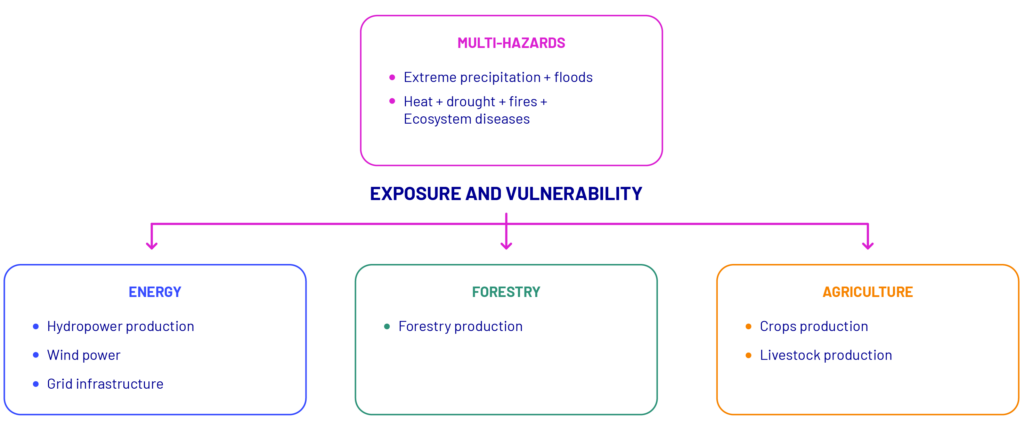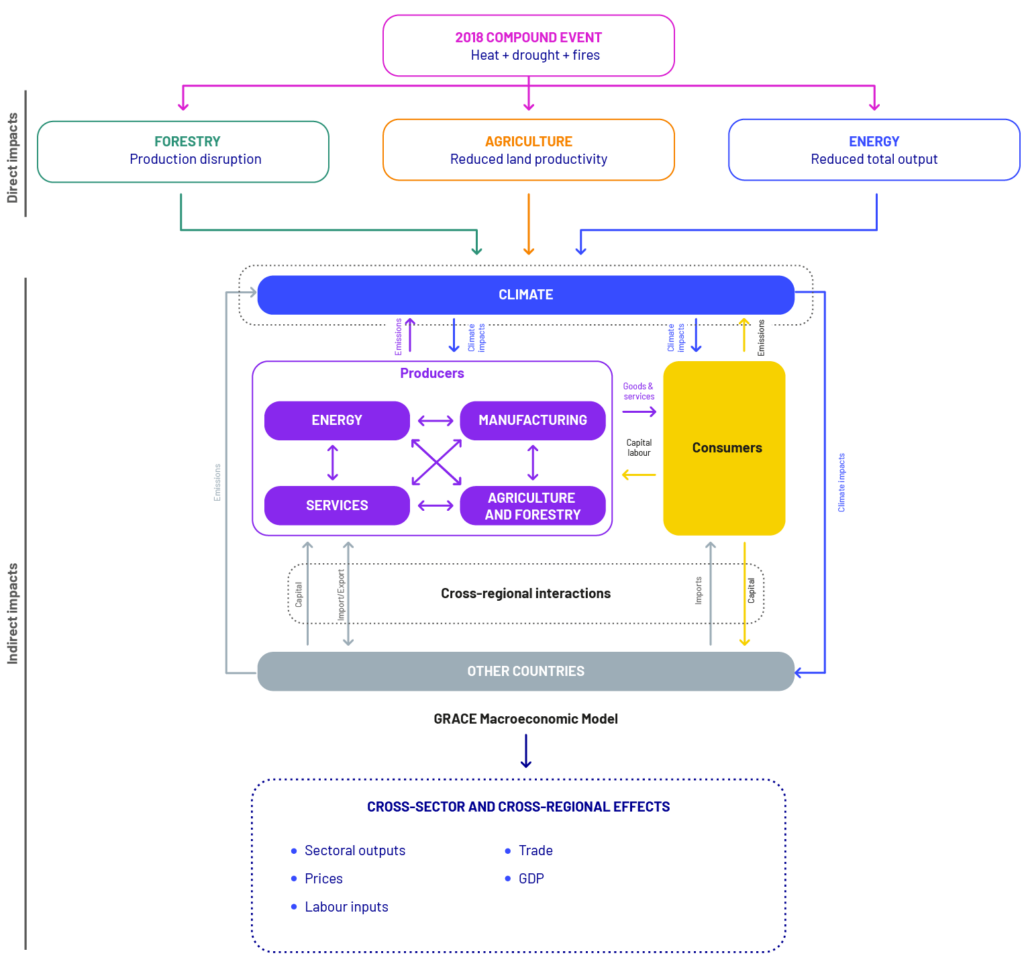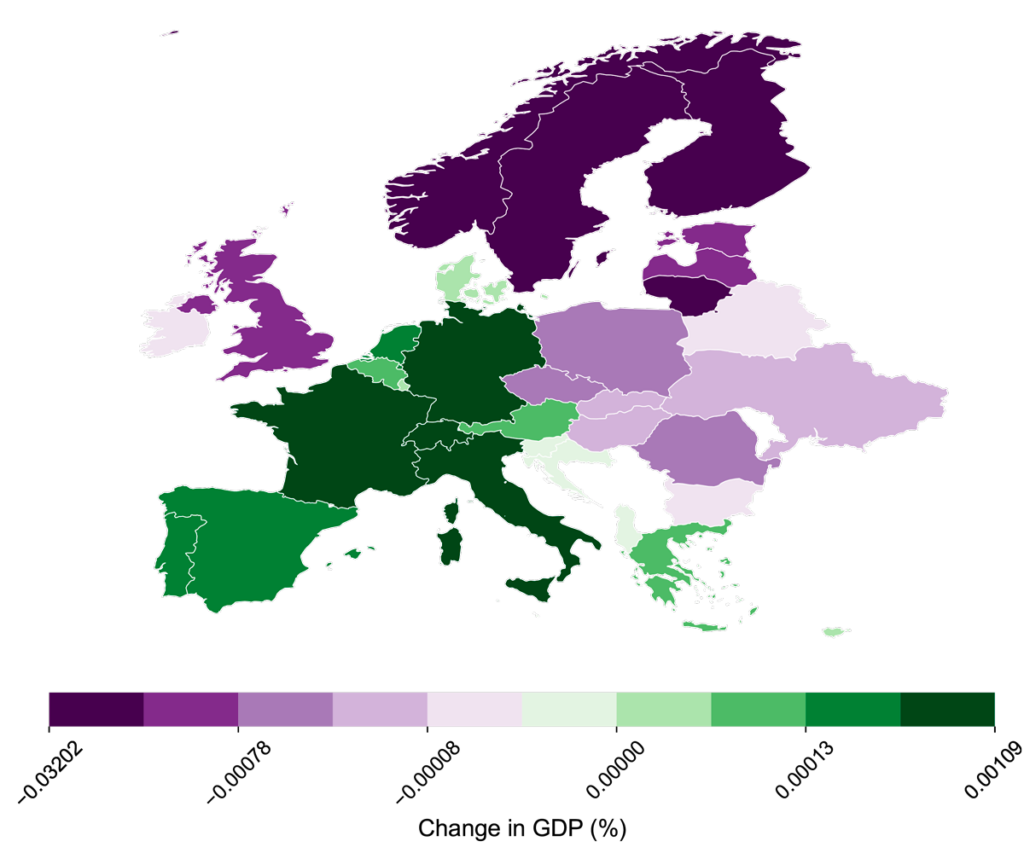- STEPS
- Finding a system definition
- Characterisation of direct risk
- Characterisation of indirect risk
- Evaluation of direct and indirect risk
Scandinavia
SUMMARY
The Scandinavian Pilot centres on agriculture, forestry, and energy—three sectors particularly vulnerable to climate change impacts, such as fluctuations in water availability. For instance, extreme rainfall may cause floods, while heatwaves and droughts can lower agricultural productivity, exacerbate forest fires, or expand biological hazards like the habitats of pine beetles. Simultaneously, the transition to a low-carbon society influences these sectors and ecosystems, as rising demands for land, energy, wood, and food intensify pressures. Climate change, coupled with society’s growing needs, challenges sectors like hydropower, wood production, and ecosystem conservation, creating new trade-offs.
The Scandinavian Pilot Study employs both qualitative and quantitative methods to explore interactions between multiple hazards from seasonal to multi-decadal scales, as well as their impacts across different sectors. Through collaboration with stakeholders and decision-makers across Scandinavia, the pilot focuses on:
Better understanding the relationship between multi-hazards affecting water availability and their effects on key sectors such as agriculture, forestry and energy.
Assessing the economic consequences of multi-hazard events at the national level and remotely.
Investigating the direct and indirect impacts and risks of these events, looking at cross-sectoral effects.
Highlighting nature’s role in managing climate risks from multi-hazards that simultaneously affect multiple sectors (e.g. Wetlands as game-changers for climate change mitigation and adaptation)
Relationship to the MYRIAD-EU Framework
Finding a system definition

The Scandinavian pilot employs a range of tools and methods to define the system (see Figure 1) under study. This process involves engaging stakeholders through interviews to identify challenges in disaster risk management (DRM) across the region (Šakić Trogrlić et al., 2024). Notably, discussions with the Norwegian Directorate for Civil Protection provided valuable insights into the system, as their role involves maintaining a comprehensive overview of risks and vulnerabilities at local, regional, and national levels. Regular exchanges with the Wetland International also contributed to the system definition. Additional approaches to refining the system definition include storytelling techniques to analyse historical multi-hazard events (in collaboration with UKRI BGS) and applying the Dynamic Adaptive Policy Pathways (DAPP, in collaboration with Deltares) method to develop forward-looking risk management strategies.
As part of the MYRIAD-EU project, the Scandinavian pilot examines the wide-ranging impacts of multi-hazard events on critical sectors such as agriculture, forestry, and energy—industries particularly vulnerable to climate change in the region. By focusing on water-related multi-hazards, including heat-drought-fire and extreme precipitation-flood scenarios, the pilot stresses the challenges these events pose to Scandinavia’s climate, ecosystems, and socio-economic systems.
Characterisation of direct risk

To identify direct risks posed by multi-hazards to energy, forestry and agriculture in Scandinavia, as partly described in Figure 2, the Scandinavian pilot began with a literature review. This helped to better understand the risks specific to each sector and their individual contexts. For the agriculture sector, this work contributed to a publication on the sustainability of the food system in Norway (van Oort et al., 2024). For the energy sector it resulted in a collaboration with the SUSRENEW project and a joint workshop.
The Scandinavian pilot continued their investigations by analysing past events to better understand direct impacts, exposure and vulnerabilities from multi-hazards events. They then focused on one specific past event, the summer of 2018, which was exceptionally unusual in Scandinavia from a climatological perspective. After an unusually warm and dry spring, the summer experienced extreme heat and drought, accompanied by widespread forest fires and the outbreak of ecosystem diseases (Ducros et al., 2024). See here, for more information on the event.
In addition to quantitative analysis, the Scandinavian pilot complemented their investigations with qualitative assessments using the storyline approach to the multi-hazard event of 2018. This approach allowed them to expand their sectors of interest, including the health sector, as well as covering a wider range of impacts on nature (e.g. ecosystem diseases).
Characterisation of indirect risk
To characterise indirect and direct risks from multi-hazards as described in Figure 3, the Scandinavian pilot employed the macroeconomic GRACE model (Aaheim et al., 2018). GRACE (Global Responses to Anthropogenic Changes in the Environment) is a computable general equilibrium model designed to assess the economic impacts of climate policies and climate change on the global economy. The model categorises economic activities worldwide into regions and sectors, using projections of population growth, investments, technological advancements, and climate change scenarios to estimate how key economic indicators, as defined in national accounts, are influenced. More information on the GRACE model can be found here: The GRACE Model. Combining the direct sectoral impacts of 2018 multi-hazards, the GRACE model evaluates a broad range of indirect socio-economic impacts. It includes changes in sectoral outputs, prices, labour inputs, trade, and GDP as shown in Figure 3.

Evaluation of direct and indirect risk
To evaluate direct and indirect risks from multi-hazards, the Scandinavian pilot built on the two previous steps, resulting in the following publication on the impacts and risks from the multi-hazard event of 2018 (Ducros et al., 2024).
The article shows:
- Direct Impacts: Negative impacts were observed on the production of agriculture, forestry, and electricity sectors. These industries faced significant challenges due to the direct consequences of multi-hazard events, affecting their overall productivity and stability.
- Indirect Impacts: The multi-hazard events caused a rise in the prices of various products, reflecting disruption in the supply chain. The refined oil sector and manufacturing experienced declines, while the production of crude oil and gas increased. In response to these changes, there was a notable reallocation of labour across different sectors. Additionally, the 2018 events led to a decrease in the trade balance of forestry goods in Scandinavia.
- Cross-regional impacts: The 2018 event led to cross-regional impacts through bilateral trade. It resulted in widespread economic impacts within Europe as shown in Figure 4, showing the impacts on the GDP. Five out of eight European regions, which are crucial trading partners for Scandinavian forestry products, experienced a decline in their trade balance, highlighting the broader economic impact of the multi-hazard events.

This type of analysis, documenting different types of impacts, contributes to a better understanding of climate risks from multi-hazards in the Scandinavian region.
References:
- Aaheim, A, A Orlov, T Wei and S Glomsrød (2018). GRACE model and applications. CICERO Report 2018/1. Centre for International Climate and Environmental Research, Oslo, Norway.
- Ducros, G., Tiggeloven, T., Ma, L., Daloz, A. S., Schuhen, N., and de Ruiter, M. C.: Multi-hazards in Scandinavia: Impacts and risks from compound heatwaves, droughts and wildfires, EGUsphere [preprint], https://doi.org/10.5194/egusphere-2024-3158, 2024.
- Šakić Trogrlić, R., Reiter, K., Ciurean, R. L., Gottardo, S., Torresan, S., Daloz, A., Ma, L., Padrón Fumero, N., Tatman, S., Hochrainer-Stigler, S., de Ruiter, M. C., Schlumberger, J., Harris, R., Garcia-Gonzalez, S., García-Vaquero, M., Arévalo, T. L. F. A., Hernandez-Martin, R., Mendoza-Jimenez, J., Mauro Ferrario, D., Geurts, D., Stuparu, D., Tiggeloven, T., Duncan, M. J., Ward, P. J.: Challenges in assessing and managing multi-hazard risks: A European stakeholders perspective, Environmental Science & Policy, Volume 157, 2024, 103774, ISSN 14629011, https://doi.org/10.1016/j.envsci.2024.103774
- van Oort, B., Daloz, A.S., Andrew, R. et al. Ruminating on sustainable food systems in a net-zero world. Nat Sustain 7, 1225–1234 (2024). https://doi.org/10.1038/s41893-024-01404-9
